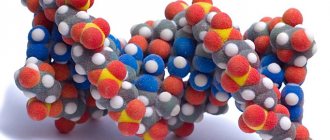The pulse is the rhythmic movement of the walls of blood vessels that occurs under blood pressure during heart contraction. The pulse rate is a relative value and depends on age, the state of the vascular system, fitness and general chronic diseases. There are several types of pulse:
- arterial - the most informative indicator of the functioning of the heart, blood vessels and blood circulation in general, and is measured, as a rule, on the radial artery of the hand;
- venous - measured by palpation of the jugular vein in the neck;
- capillary - assessed by changes in the color of the nail bed or forehead.
The pulse is characterized by the following properties that are used in the diagnosis of cardiovascular diseases:
- rhythm (cyclical or irregular) is determined by the intervals between beats;
- HR – heart rate, which is measured in numbers;
- the magnitude of the pulse impulse (large, small, threadlike or intermittent);
- tension (hard or soft);
- filling (full or empty).
Changes in rhythm, tension, filling may indicate the presence of tachycardia, bradycardia, pathologies of the heart valves, heart blocks, etc.
About the human pulse
Oxygen enters human organs and tissues with blood flowing through arteries (blood vessels through which blood is carried from the heart) under a certain pressure - arterial. This causes vibration of the arterial walls. The forward and reverse movement of blood to the heart also (normally) causes emptying and filling of the veins. Under the influence of blood pressure, red blood cells (red blood cells) are forced through capillaries (the thinnest blood vessels), overcoming high resistance; Electrolytes (substances that conduct electric current) pass through their walls.
This creates pulse beats that are felt throughout the body, in all vessels. An amazing phenomenon! Although in reality it is a pulse wave - a wave of movements of the walls of blood vessels under pressure, which is very fast and sounds like a short sound. The number of these waves normally corresponds to the number of heart contractions.
How to calculate?
The most accessible way to measure heart rate is palpation, a manual method based on touch.
Quick and simple, it does not require special training. To obtain the most accurate reading, place your index and middle fingers on the surface of the skin over the artery and count the pulse for 60 seconds. You can also use a faster method by determining your pulse in 20 seconds and multiplying the resulting value by 3.
Measures to help with a critically high heart rate
It is always worth remembering that a pulse exceeding 160 beats per minute poses a danger to human health and life. Especially if it is accompanied by symptoms such as:
- dyspnea;
- chest pain;
- tremor of the limbs;
- veins protruding from the neck;
- darkening of the eyes and lightheadedness.
Chest pain is one of the symptoms with a maximum pulse.
In such a case, the first thing to do is call an ambulance. Then, before the arrival of specialists, you should try to reduce the indicators as much as possible. For this purpose, the person is seated with a pillow or bolster made of blanket under his back. Next, by providing an influx of fresh air and through breathing exercises, they try to reduce the heart rate.
In such a situation, it is better not to put the person down, as breathing problems are possible. But you can give him half a glass of cold water to drink. If nothing works, then you can resort to sedatives, such as valerian or motherwort tablets. In the most extreme cases, you can use Captopril or Moxonidine. Hospitalization in such cases is mandatory, even if it was possible to bring the pulse back to normal at home. It must be remembered that a rapid pulse is just a signal of a more serious disease that should not be ignored.
Why can heart rate change at rest?
The main factors influencing changes in heart rate:
- when the temperature and/or humidity increases, the heart rate increases by 5 – 10 beats per minute;
- when moving from a lying position to a vertical one, heart rate increases in the first 15–20 seconds, then returns to its original value;
- heartbeat increases with tension, anxiety, expressed emotions;
- in people with large weight, the heart rate is usually higher than in people of the same age and gender, but with normal body weight;
- with fever, an increase in temperature of 1 degree is accompanied by an increase in heart rate by 10 beats per minute; There are exceptions to this rule, when the heart rate does not increase so much - these are typhoid fever, sepsis and some variants of viral hepatitis.
Reasons for the slowdown
First of all, you need to make sure that the pulse measurement is carried out technically correctly. A heart rate less than 60 per minute is not always associated with health problems. It can be caused by medications such as beta blockers.
Rare heartbeat (up to 40 per minute) is often observed in physically active people or professional athletes. This is due to the fact that their heart muscle contracts very well and is able to maintain normal blood flow without additional effort. Below we provide tables that allow you to roughly determine a person’s physical fitness by his resting heart rate.
Heart diseases such as ischemic heart disease, endocarditis, myocarditis, as well as some other diseases - hypothyroidism (insufficient hormonal activity of the thyroid gland) or an imbalance of electrolytes in the blood can lead to a slow heartbeat.
Reasons for the increase
The most common cause of accelerated heart rate is inadequate rest before measurement. It is best to measure this indicator in the morning after waking up, without getting out of bed. You should also make sure that your heart rate is counted correctly.
Children and adolescents have a higher heart rate than adults. Other factors that increase heart rate:
- use of caffeine or other stimulants;
- recent smoking or drinking alcohol;
- stress;
- high blood pressure.
Most illnesses increase heart rate, including fever, congenital heart defects, and hyperthyroidism.
Pulse rate
The heart pushes blood into the vessels. Because of this, vibrations of the arteries occur. This is called the pulse or heart rate, because each contraction is accompanied by the expulsion of blood. The maximum human heart rate is 80 beats/min. It increases with physical training, stress, severe anxiety, alcohol intake, elevated body and air temperature. The pulse rate varies from person to person and is determined by the age and gender of the person. In newborns, the maximum heart rate reaches 140 beats. A woman's heartbeat is 5-10 units higher than a man's. Athletes have a lower permissible heart rate than untrained people.
Peculiarities
Pulse - (Pulsus) translated from Latin means blow, push. The frequency and force of heart contraction causes vascular vibrations. If the subject is healthy, then they are rhythmic and have the same period of time. Rhythm disturbances, weakening or increasing pulsation indicate the development of the disease. There are 3 types in total:
Read also How much water does a person need to drink per day to feel great? Simple formula
Arterial
It represents jerky movements of the walls of the arteries, which are formed due to periodic changes in blood filling.
Where can you feel your pulse?
The pulse can be felt in several places on the human body and therefore can be measured:
- On the wrist - the radial artery pulsates
- Ulnar Artery - Look for the ulnar artery, which is located in the crook of the elbow.
- In the armpit
- On the temples
- Temporal artery above the eyebrows
- The neck is the location of the carotid artery
- Corner of the mouth (edge of the jaw) – there you can feel the facial pulse.
- Groin – here you can feel the femoral pulse
- Below the knee (where the leg bends is the popliteal artery).
- Foot or arch
Heart rate tables by age
To find out whether your heart rate is normal for healthy people, it should be measured and compared with the indicators presented in the table by age. In this case, a deviation from the specified standard will in most cases indicate unsatisfactory functioning of the vascular walls or improper functioning of the circulatory system as a whole.
For men
| Physical state | 1 age category | 2nd age category | 3 age category | 4 age category | 5 age category | 6 age category |
| Age table for men | 18 – 25 years old | 26 - 35 years | 36 – 45 years | 46 - 55 years | 56 - 65 years old | 65 and older |
| Athletes | 49-55 beats min. | 49-54 beats min. | 50-56 beats min. | 50-57 beats min. | 51-56 beats min. | 50-55 beats min. |
| Excellent | 56-61 beats min. | 55-61 beats min. | 57-62 beats min. | 58-63 beats min. | 57-61 beats min. | 56-61 beats min. |
| good | 62-65 beats min. | 62-65 beats min. | 63-66 beats min. | 64-67 beats min. | 62-67 beats min. | 62-65 beats min. |
| Better than average | 66-69 beats min. | 66-70 beats min. | 67-70 beats min. | 68-71 beats min. | 68-71 beats min. | 66-69 beats min. |
| Average | 70-73 beats min. | 71-74 beats min. | 71-75 beats min. | 72-76 beats min. | 72-75 beats min. | 70-73 beats min. |
| Worse than average | 74-81 beats min. | 75-81 beats min. | 76-82 beats min. | 77-83 beats min. | 76-81 beats min. | 74-79 beats min. |
| Bad | 82+ beats min. | 82+ beats min. | 83+ beats min. | 84+ beats min. | 82+ beats min. | 80+ beats min. |
What a person's pulse is is affected by his fitness and habit of frequent exercise that requires endurance - for example, medium and long distance running, walking, rowing, cycling, swimming. The heart muscle of such athletes is able to pump the same volume of blood in fewer contractions (athletic heart syndrome).
For women
| Physical state | 1 age category | 2nd age category | 3 age category | 4 age category | 5 age category | 6 age category |
| Age table for women | 18 – 25 years old | 26 - 35 years | 36 – 45 years | 46 - 55 years | 56 - 65 years old | 65 years and older |
| Athletes | 54-60 beats min. | 54-59 beats min. | 54-59 beats min. | 54-60 beats min. | 54-59 beats min. | 54-59 beats min. |
| Excellent | 61-65 beats min. | 60-64 beats min. | 60-64 beats min. | 61-65 beats min. | 60-64 beats min. | 60-64 beats min. |
| good | 66-69 beats min. | 65-68 beats min. | 65-69 beats min. | 66-69 beats min. | 65-68 beats min. | 65-68 beats min. |
| Better than average | 70-73 beats min. | 69-72 beats min. | 70-73 beats min. | 70-73 beats min. | 69-73 beats min. | 69-72 beats min. |
| Average | 74-78 beats min. | 73-76 beats min. | 74-78 beats min. | 74-77 beats min. | 74-77 beats min. | 73-76 beats min. |
| Worse than average | 79-84 beats min. | 77-82 beats min. | 79-84 beats min. | 78-83 beats min. | 78-83 beats min. | 77-84 beats min. |
| Bad | 85+ beats min. | 83+ beats min. | 85+ beats min. | 84+ beats min. | 84+ beats min. | 84+ beats min. |
Movement helps train the blood organs; Cardio exercises (from the Greek kardio, heart) with regularity significantly increase both the length of life and its quality. And they do not require any special means: even an ordinary walk (not even necessarily every day!) with a subjectively fast step instead of immobility fundamentally improves the condition.
Thus, the normal heart rate for a trained and physically healthy person may be lower than the generally accepted normal heart rate.
In childhood, the pulse is a very variable value and changes often. In a newborn, the heart contracts at a rate 2 times higher than in an adult. The older the child, the closer the values are to adults. During adolescence (about 15-18 years), the heart rate gradually decreases and is compared with the heart rate of adults.
Read also Chapping of the skin of the face, hands and lips. Prevention and treatment of chapping
Normal heart rate for an adult: table by age
The normal heart rate of an adult by year (age) is given in the table:
| Age | Maximum and minimum limit | Average value |
| 15-50 years | 60-80 | 70 |
| 50-70 years | 66-87 | 76 |
| From 70 years old | 72-92 | 81 |
In an adult, the heart rate norms by age and the permissible heart rate limits in a child under 15 years of age differ significantly, which can be seen in the following table:
| Age | Maximum and minimum limit | Average value |
| Up to 3-4 weeks | 115-165 | 135 |
| From 1 to 12 months | 105-160 | 130 |
| 1-3 years | 90-150 | 122 |
| 3-5 years | 85-135 | 110 |
| 5-7 years | 80-120 | 100 |
| 7-9 years | 72-112 | 92 |
| 9-11 years | 65-105 | 85 |
| 11-15 years | 58-97 | 77 |
Knowing what the normal heart rate is for women and men by age, you can avoid many diseases. Measurements should be taken at rest. Under the influence of other factors (sports, pregnancy), slight deviations are possible.
Heart rate while walking
While walking, there is a slight increase in heart rate. How many heartbeats there will be per minute depends on the person’s fitness. For people leading a sedentary lifestyle, the heart rate can jump to 120, but for people who like to walk, it will remain within 90-100. To calculate the maximum permissible limit, subtract the person's age from 180.
When walking, the permissible heart rate is as follows:
- 15 years - 165;
- 35 years old - 145;
- 55 years old - 125;
- 75 years old - 105.
Heart rate at rest
The resting pulse is determined in the morning. A person needs to sit on a chair and count his pulse. Changing body positions or taking measurements in the evening is not recommended, as the final result will be distorted.
Generally accepted norms at rest:
- adults – 60-80;
- elderly – 70-90;
- teenagers - 70-80;
- children under 2 years old - 90-100;
- newborns - 130-140.
Heart rate while running
While jogging, a lot of stress is placed on the heart. People trying to lose weight should keep their heart rate close to the upper limit. If the goal is to strengthen the cardiovascular system, then you need to stop at a figure not exceeding 60-70%. To calculate the norm, you need to subtract your age from 200:
| Age | Maximum allowable heart rate | Pulse for weight loss | Pulse to strengthen the heart and increase endurance |
| 30 | 170 | 155-160 | 110-120 |
| 50 | 150 | 135-140 | 90-110 |
| 70 | 130 | 115-120 | 70-90 |
If, against the background of an increase in the pulse (within acceptable limits), the pressure readings remain normal, then the development of pathologies will not follow. Elderly people need to be especially careful. Their body is unable to withstand heavy loads.
Permissible heart rate during pregnancy
A woman who is expecting a baby experiences increased heart rate around the 5th month. This phenomenon is associated with an increase in circulating blood volume during fetal development. Usually the increase is insignificant and gradually the indicators return to the acceptable limit:
- at 14-26 weeks there is an increase of 10-15 contractions from the norm;
- the maximum increase occurs between 27 and 32 weeks;
- gradual normalization occurs closer to the birth of the child.
Average heart rate standard for children
The average reference values of cardiac pulsation in children differ quite significantly from the heart rate in adults. is considered normal for newborns .
As the child grows up, the heart rate gradually decreases and by the end of puberty (adolescence) it stops at 60-90 pulsations per minute . What indicators are acceptable for children are shown in the table.
It should be noted that the frequency of pulsation in children is different - one in the morning, completely different in the evening and during night sleep. The most optimal time to measure it is immediately after sleep.
Regularly measuring the child’s pulse will help prevent possible problems in time, or make sure that the child’s heart is functioning normally.
A fairly simple procedure for measuring your pulse will help you quickly diagnose the development of possible diseases.
If children have a rapid heart rate and it is not provoked by physical or emotional stress, this is a good reason to seek medical help.
Allowable increase
The pulse varies depending on gender and age.
A person's pulse can only rise 5 beats per minute from the maximum allowable rate. That is, the data should be no more than 83-85 beats/min. in an adult. An acceptable increase in heart rate is most often found in people from 15 to 45 years old in situational circumstances. This is a short-term disturbance in heart rate. It is known that in females the indicators are 5 points higher than in men of the same age, and during menopause the difference is 7-10 units.
What heart rate is considered normal for a child at 6, 7, 8, 9, 10, 11, 12 years old?
| Child's age | Minimum (normal) number of beats | Average (normal) number of beats | Maximum (normal) number of strokes |
| 6 years | 90 | 92 | 95 |
| 7 years | 83 | 85 | 90 |
| 8 years | 80 | 83 | 85 |
| 9 years | 80 | 83 | 85 |
| 10 years | 78 | 80 | 85 |
| 11 years | 78 | 82 | 85 |
| 12 years | 75 | 80 | 82 |
What heart rate is considered normal for a teenager at 13, 14, 15, 16, 17 years old?
| Child's age | Minimum (normal) number of beats | Average (normal) number of beats | Maximum (normal) number of strokes |
| 13 years | 72 | 75 | 80 |
| 14 years | 72 | 75 | 78 |
| 15 years | 70 | 73 | 76 |
| 16 years | 68 | 70 | 72 |
| 17 years | 65 | 67 | 70 |
During pregnancy
In pregnant women, starting from 20-22 weeks, an increase in heart rate is recorded. This is due to the increased volume of circulating blood. Often changes do not go beyond the maximum permissible limits. For example, at 3-5 months the number of strokes increases by 10-15, then until the 8th month it reaches maximum levels. By the time pregnancy is completed, it will stabilize.
How to measure the pulse on the hand on the wrist yourself and determine the pulse on the carotid artery?
Measuring your pulse is very simple:
- You will need to have a watch that will measure the time and number of heartbeats over a certain period of time.
- Calm down and sit down, find a quiet and peaceful room.
- Place the index and middle finger of your right hand at the site of the artery pulsation (wrist, neck or other part of the body).
- Record the time (from 30 to 60 seconds) and count the number of beats during this period of time.
- Check the data with the table
How to measure your pulse
As mentioned above, many modern devices (Apple Watch, fitness trackers from Xiaomi, Samsung, etc.) can perform this function. In addition, there are applications for measuring heart rate using the camera and flash of a regular smartphone, the best of these programs is Cardiio: Heart Rate Heart Rate.
Of course, there are special devices, but the simplest and most effective method for determining heart rate remains palpation (measurement by touch), which allows you to accurately count the number of beats and determine arrhythmic deviations.
It should be borne in mind that the pulse in the lying, sitting and standing positions of the body may differ; there is a slight difference even between the wrists of the left and right hands.
♥ ON TOPIC: Review of a set of home exercises 7-minute fitness training program from Johnson & Johnson.
What heart rate is considered normal?
Heart rate is affected not only by diseases, but also by temporary external influences. As a rule, a temporary increase in heart rate can be restored after a short rest and elimination of provoking factors. What should be the normal heart rate for a person in various conditions?
At rest
The value that is considered the normal heart rate for an adult is actually the resting heart rate.
That is, when talking about the norm of a healthy heartbeat, we always mean the value measured at rest. For an adult, this norm is 60-80 beats per minute, but under certain conditions the norm can be 50 beats (in trained people) and 90 (in women and young people).
During physical activity
To calculate what a person’s normal heart rate is during moderate physical activity, experts offer the following mathematical operations:
- The maximum heart rate is calculated as the difference between the number 220 and the number of complete years of a person. (For example, for 20-year-olds this value will be: 220-20=200).
- Minimum heart rate value (50% of maximum): 200:100x50 = 100 beats.
- Normal heart rate under moderate loads (70% of maximum): 200:100x70 = 140 beats per minute.
Physical activity can have different intensities - moderate and high, depending on which the heart rate of the person receiving these activities will be different.
Let us remember that for moderate physical activity the heart rate ranges from 50 to 70% of the maximum value, calculated as the difference between the number 220 and the total number of years of a person.
When running
During high physical activity, an example of which is running (as well as speed swimming, aerobics, etc.), the heart rate is calculated according to a similar scheme. To find out what a person’s heart rate is considered normal while running, use the following formulas:
- Find out the difference between the number 220 and a person’s age, that is, maximum heart rate: 220-30 = 190 (for 30-year-olds).
- Determine 70% of the maximum: 190:100x70 = 133.
- Determine 85% of the maximum: 190:100x85 = 162 beats.
The normal heart rate when running ranges from 70 to 85% of the maximum value, which is the difference between 220 and the person’s age.
For burning fat
The formula for calculating maximum heart rate is also useful when calculating the heart rate rate for burning fat.
Most fitness trainers use for calculations the method of the Finnish physiologist and military doctor M. Karvonen, who developed a method for determining heart rate limits for physical training. According to this method, the target zone or FBL (fat burning zone) is a heart rate ranging from 50 to 80% of your maximum heart rate.
Read also: Stress at work: prevention of professional stress
When calculating the maximum heart rate, the norm by age is not taken into account, but age itself is taken into account. For example, let’s take the age of 40 years and calculate the heart rate rate for life-saving lifestyle:
- 220 – 40 = 180.
- 180x0.5 = 90 (50% of the maximum).
- 180x0.8 = 144 (80% of the maximum).
- The heart rate ranges from 90 to 144 beats per minute.
Why is there such a discrepancy in numbers? The fact is that the normal heart rate for training should be selected individually, taking into account fitness, well-being and other characteristics of the body. Therefore, before starting training (and during it), a medical examination is necessary.
After meal
Gastrocardiac syndrome - a noticeable increase in heart rate after eating - can be observed in various diseases of the gastrointestinal tract, cardiovascular, and endocrine systems. A pathological condition is indicated by a heartbeat that is significantly higher than normal. Is there really a norm for heart rate to increase while eating?
Strictly speaking, a slight increase in heart rate during or 10-15 minutes after a meal is a physiological condition. Food entering the stomach puts pressure on the diaphragm, which forces a person to breathe deeper and more often - hence the increase in heart rate. Exceeding the normal heart rate occurs especially often when overeating.
But even if little food is eaten, and the heart still starts beating faster, this is not always a sign of pathology. Simply, digesting food requires an increase in metabolism, and for this a slight increase in heart rate is required.
The heart rate after eating is approximately equal to the normal value during moderate physical activity.
We have already learned how to calculate it, all that remains is to compare your own pulse after eating with the norm calculated using the formula.
Is increased heart rate dangerous?
An elevated heart rate is a risky condition. The heart experiences maximum stress during physical activity. This is a muscular organ that, like all muscles, gets tired. During training, the heart tenses up and starts working faster. Then the interval between periods of rest of the heart muscle (myocardium) decreases. The heart does not fill well with blood, and hypoxia occurs. This leads to complications and can cause cardiac arrest. This is especially true for people whose heart muscle is untrained. The critical resting heart rate for a healthy person is 160-170 beats per minute. The fatal pulse for diseases of the cardiovascular system is 100 beats/min; at such a heart rate the heart may not be able to withstand it.
Symptoms of heart rhythm disturbances
It happens that a person may not notice an arrhythmia, but finds out about it during routine medical examinations. But more often the disease makes itself felt.
Signs of heart rhythm disturbances include:
- accelerated heartbeat;
- slow heartbeat;
- feeling the heartbeat;
- shortness of breath with minor exertion;
- chest pressure or pain;
- dizziness;
- fainting or lightheadedness.
Symptoms of heart failure
Pathological forms of arrhythmia are especially dangerous. They manifest themselves quite clearly and often lead to the development of severe complications. In addition to signs of a slow or accelerated heartbeat, symptoms of an underlying pathological process may occur.
Tachycardia is characterized by the following clinical picture:
- feeling of heartbeat;
- dizziness;
- pain and tightness in the chest;
- dyspnea;
- increased blood pressure;
- sense of anxiety;
- pulsation of blood vessels in the neck;
- irritability;
- insomnia;
- lack of air.
Bradycardia manifests itself when the heart rate decreases to 40 beats per minute or lower with the following symptoms:
- dizziness attack;
- fainting state;
- pale skin;
- growing weakness
- chest pain;
- fast fatiguability;
- seizures;
- respiratory dysfunction.
Possible diseases due to changes in heart rate
In addition to heart disease, pulsation failures can cause the following diseases:
- problems of the thyroid gland (with insufficient function of this organ, the pulse slows down, and with hyperfunction, on the contrary, it accelerates too much, even sometimes causing flickering arrhythmia);
- osteochondrosis of the cervicothoracic spine;
- poisoning (loss of electrolytes: potassium, sodium, chlorine, etc.);
- improper nutrition (fasting, incorrectly selected dietary supplements);
- kidney and liver diseases (if there are disturbances in the functioning of these organs, the blood is not sufficiently purified, therefore, it is more difficult for the heart to pump it).
If the heart rhythm is disturbed, complications may appear, namely:
- myocardial infarction;
- heart failure;
- sudden cardiac death;
- thromboembolism;
- acute circulatory disorder in the brain.
When to see a doctor if your heart rate is abnormal
Specialists who can help with such problems are a cardiologist and an arrhythmologist.
Symptoms for which a visit to a doctor is required:
- pain in the chest (often radiating to the neck, jaw, arms, back);
- shortness of breath and attacks of suffocation at night;
- increased blood pressure higher than 140/90;
- pressure drop is lower than 90/60;
- a feeling of interruptions in the work of the heart;
- cases of loss of consciousness;
- purple lip color;
- swelling of the legs.
How to feel a person's critical pulse
You can feel the critical pulse for a person by measuring the indicator in a standard way - on the wrist (from the inside), on the neck or in the groin area, on the elbow. Signs that you should check the pulse and take measures to save the person:
- blood pressure rises sharply;
- there are complaints of tinnitus;
- extremities begin to go numb and become cold (specifically, fingers and toes);
- large drops of sweat appear on the face.
The person begins to get nervous, he may be overcome by an attack of fear of death, and shortness of breath occurs. Complaints about darkening of the eyes and pain in the chest (the area of the anatomical location of the heart) are a signal that you need to immediately call an ambulance, because the patient requires resuscitation measures.










